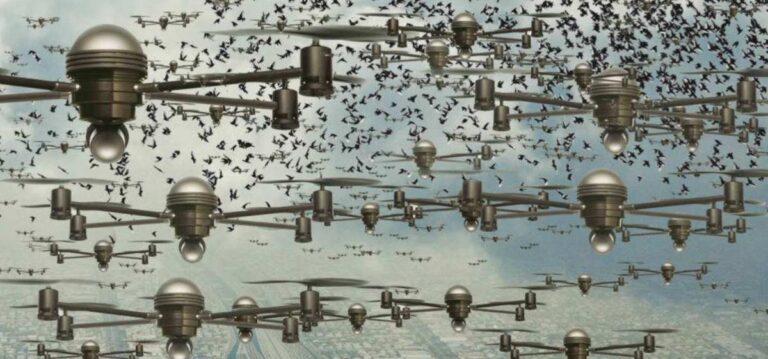The Rise of Drone Warfare: Analyzing Russia’s Shahed Strategy
In today’s rapidly evolving military landscape, the advent of unmanned aerial vehicles (UAVs) has significantly transformed how wars are fought. A recent analysis from the Center for Strategic and International Studies (CSIS) emphasizes the pivotal role that drone saturation plays in Russia’s ongoing campaign utilizing Iranian-manufactured Shahed drones.this shift in strategy marks a notable change in Moscow’s military tactics as it increasingly relies on these UAVs for both surveillance and offensive operations. As tensions escalate in ukraine, this reliance introduces new challenges for defense mechanisms and reshapes global geopolitical dynamics. This article explores the ramifications of Russia’s drone saturation approach, highlighting how these UAVs have altered combat scenarios and what this signifies for future conflicts worldwide.
The Impact of Drone Saturation on Modern combat
The increasing use of drones has revolutionized tactical methodologies on battlefields,with Russia’s deployment of Shahed drones serving as a prime illustration. These UAVs embody the principle of drone saturation, where multiple drones are launched simultaneously to overwhelm enemy air defenses. This tactic complicates decision-making processes for opposing forces by forcing them to address numerous threats concurrently.The sheer volume not only creates chaos but also enhances the chances of successful strikes, as adversary systems can quickly become inundated.
Furthermore, the effects of such saturation strategies extend beyond immediate military confrontations. The psychological toll on ground troops is important; constant aerial threats can erode morale and impair operational efficiency.An examination into shifts within conflict dynamics reveals several critical considerations:
- Accelerated Technological Arms Race: Nations may hasten efforts to develop countermeasures or upgrade their defensive capabilities.
- Tactical evolution in Warfare: Ground forces must adapt to persistent aerial reconnaissance and assaults.
- Moral Implications: The deployment of drones raises ethical concerns regarding collateral damage and civilian safety.
Strategic Advantages Offered by Russia’s Shahed Drone campaign
The rise of drone warfare has fundamentally altered traditional military strategies, with Russia’s use of Shahed drones exemplifying this transformation.These UAVs serve not only tactical purposes but also act as psychological instruments against opponents. By launching campaigns characterized by overwhelming strikes, Moscow seeks to incapacitate defensive systems while undermining public morale among its adversaries. Key elements driving this strategy include:
- Aiming at Critical infrastructure: Targeted attacks on energy resources and transportation networks disrupt daily life while impeding military logistics.
- <strong instilling uncertainty: The unpredictability associated with drone swarms compels nations to allocate resources defensively rather than offensively.
- Pushing Propaganda Narratives: Showcasing effective drone operations sends a strong message about tactical innovation to both allies and rivals alike.
This multi-faceted approach enhances their effectiveness within asymmetric warfare contexts; Russian tactics extend beyond mere brute force into broader realms encompassing influence and deterrence strategies. By integrating these UAVs into refined cyber warfare frameworks, Moscow significantly alters battlefield dynamics—operational data indicates trends showcasing calculated escalations in drone usage over time:
| Type Of Operation | Occurrence Rate | Cumulative Impact |
|---|---|---|
| Infrastructure Disruption | High | Severe |
| Civilian areas | Moderate | Psychological |
| Military Installations  <td Low <td Strategic |
Strategies for mitigating Drone Threats in Regional Conflicts
To effectively mitigate drone threats during regional conflicts requires an integrated strategy that combines technology with intelligence sharing and coordination efforts among allied nations.
Pursuing investments in counter-drone technologies is crucial;, ranging from electronic warfare systems capable neutralizing incoming threats before they cause harm through advanced missile defense platforms.
Additionally,< strong enhancing intelligence-sharing practices across allied countries can improve situational awareness enabling swift responses against potential incursions.
Coordinating air defenses across borders ensures collaborative approaches towards addressing incursions reducing risks associated insufficient protective measures.
Moreover,< strong prioritizing training personnel focused detection countermeasures shoudl be emphasized;. Conducting joint exercises improves readiness interoperability between forces involved
Implementing< strong public awareness initiatives regarding risks posed by unmanned aircraft encourages civilian engagement reporting suspicious activities thereby enhancing grassroots-level intelligence gathering capabilities
To facilitate recommendations regional governments might consider establishing< strong dedicated task force aimed combating emerging threats posed by unmanned aircraft equipped authority deploy resources swiftly efficiently throughout conflict zones
Conclusion: embracing New Realities In Warfare Dynamics Through drones’ Proliferation!
The phenomenon surrounding increased utilization unmanned aerial vehicles epitomized through Russian-led campaigns highlights significant transformations occurring within contemporary combat environments! As hostilities progress extensive deployments uncrewed aircraft alter strategic calculations impacting battlefields raising profound implications international security policies! Analysts at CSIS emphasize understanding effectiveness reach these technologies vital anticipating future challenges responses! Global powers reassess capabilities related advancements seen today ramifications stemming from such strategies reverberate far beyond borders prompting reevaluation existing doctrines worldwide! One thing remains clear—the era dominated by innovative uses involving advanced technologies like those found within modern-day warfare here stay long-term consequences felt years ahead!




